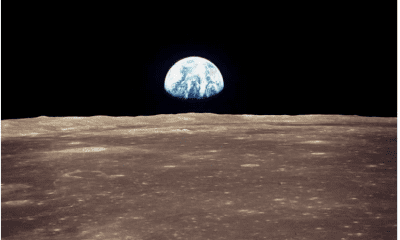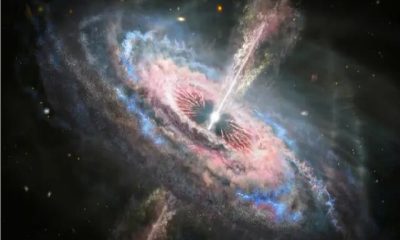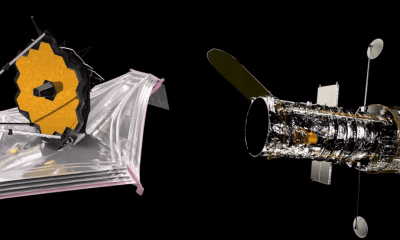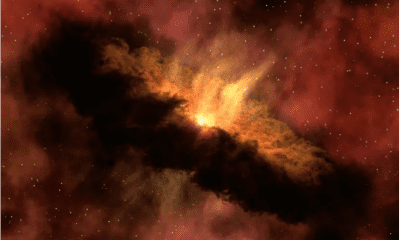Space
Discovery of 6 exoplanets around a misbehaving star!
Published
9 months agoon
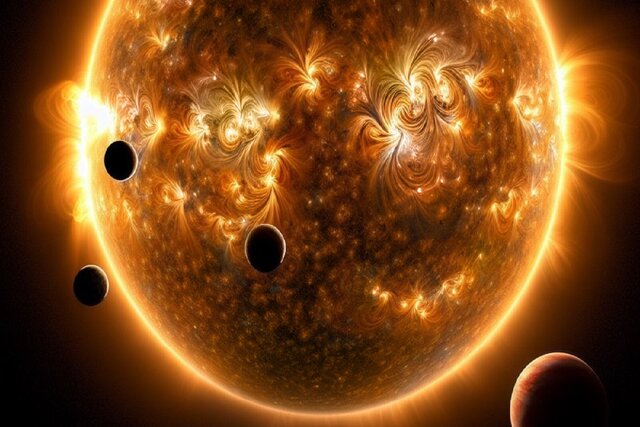

NASA’s TESS telescope has detected a rare system around a young star that contains 6 exoplanets. Here we will talk about the discovery of 6 exoplanets around a misbehaving star!
Discovery of 6 exoplanets around a misbehaving star!
Astronomers have discovered a rare system of six young planets and a possible seventh orbiting a misbehaving baby star. So we will talk about the discovery of 6 exoplanets around a misbehaving star!
Not only could this system provide much-needed information about how planets form and evolve around a baby star, but its similarity to the Solar System could provide a picture of what our cosmic neighborhood might look like in about four billion years, according to Space. has been available to astronomers.
Six or possibly seven exoplanets orbit a dwarf star called TOI-1136, which is 270 light-years away from Earth. The large number of exoplanets in this system has prompted scientists to take a deeper look at it.
“Tara Fetherolf”, visiting professor of astrophysics at “The University of California” and one of the researchers of this project, said: Since few star systems have planets the size of this system, its size is close to the solar system. This system is both so similar to the solar system and so different from it that it can provide many tips to astronomers.
Scientists first surveyed the planetary system using NASA’s Transiting Extrasolar Mapping Satellite, or TESS, in 2019. Fetterolf and his colleagues followed up this initial research with multiple telescope observations and were able to reveal the planets’ masses, shapes, orbits, and even atmospheric properties.
Read More: NASA launches the first gravitational wave space telescope
Planets in this system with assigned names between “TOI-1136 b” and “TOI-1136 g” are classified as “sub-Neptunian planets”. The smallest of the 6 confirmed planets is twice as wide as Earth; While some of its sibling planets are up to four times larger than our planet and their size is roughly equivalent to the solar system’s ice giants, Uranus and Neptune.
All of the exoplanets in TOI-1136 are so close to their parent star that they complete one orbit in less than 88 Earth days. This is important because the orbital period of Mercury, which is the closest planet to the Sun, is 88 days. This means that all these planets may be closer to their star than that dwarf planet is to our star.
“Rae Holcomb” (Rae Holcomb), a doctoral student in physics at the University of California and one of the researchers of this project said: “They are strange planets for us because we don’t have anything exactly like them in the solar system, but the more we study planetary systems, it seems It turns out that they may be the most common type of planet in the galaxy.
What really sets TOI-1136 apart is the youngness of the planet and its central dwarf star. The star TOI-1136 is only 700 million years old and may seem ancient, but compared to the 4.5 billion-year-old Solar System and its Sun, it looks like a toddler.
“This will help us study planets soon after they form, and the formation of the solar system is a hot topic,” Fetterolf said. Every time we find a multiplanet system, it gives us more information to process our theories about how systems formed and how our solar system got here.
Just like a hyperactive toddler, these newborn stars are hard to track because of their hyperactivity. For young stars, this hyperactivity has manifested itself in the form of strong magnetization, more frequent and intense sunspots, and solar flares.
The radiation emitted by young stars not only makes them challenging to observe but also shapes the planets orbiting the stars and their atmospheric properties.
Stephen Kane, professor of planetary astrophysics at the University of California, Riverside (UCR) and head of this research group said: Young stars always behave badly. They are very active just like toddlers. This feature can make it difficult to check with high precision. On the other hand, this feature will help us not only compare one-by-one how the planets change over time but also help us understand how their atmospheres have evolved at different distances from the star, perhaps most importantly.
Possibility of hosting life
All the planets in the TOI-1136 system are not only relatively the same age but also physically close to each other. This feature gave researchers the opportunity to study something that would not be easy to study in another planetary system.
“Usually when we look for planets, we look at the influence of the planets on their own star,” Kane said. We see the motion of the star and interpret this motion as the gravitational effect of the planets on it. Also, we can see planets pulling each other.
This proximity allowed the team to detect a resonant force in the system, indicating that the seventh planet could gravitationally influence the six confirmed planets.
Using the Automatic Planet Finder Telescope (APF Telescope) at the Lick Observatory in California and the High-Resolution Echelon Spectrometer (HIRES) at the Keck Observatory in Hawaii, the researchers were able to stagger. Identify the dwarf star TOI-1136 that was formed when the planets pulled on it.
Combining observations of this motion with computer models and data from planets passing in front of their star allowed researchers to determine the planets’ masses with unprecedented precision.
Corey Beard, PhD student in physics at UC Irvine and the senior researcher of this project said: Trial and error took a lot of time, but we are really happy with our results after developing one of the most complex models of the planetary system. Among the exoplanets that have been studied to date, we were happy.
The likelihood that the planets in this system could support life seems slim at best due to their proximity to their host star. This means that the star’s intense radiation would likely destroy these planets’ atmospheres and boil off liquid water, a vital element for life.
“I am convinced that our system is very unusual in the world,” Kane said. Finding systems unlike our own reveals how our own solar system fits into the story of formation around other stars.
The research team now plans to further investigate the TOI-1136 system, hoping to confirm the seventh planet and determine the composition of the planets’ atmospheres. Perhaps this result can be obtained using the “James Webb Space Telescope”.
This research was published in “The Astronomical Journal”.


You may like


Why is it still difficult to land on the moon?
This year, the private company Spacel and the Indian Space Organization both met tragic ends when they tried to land their spacecraft on the surface of the moon. Despite the astonishing leaps made in recent decades in computing, artificial intelligence and other technologies, it seems that landing on the moon should be easier now; But recent setbacks show that we still have a long way to go with safe and trouble-free landings on the surface of Earth’s only moon.
50 years after sending the first man to the surface of the moon, the question arises as to why safely landing a spacecraft on Earth’s nearest cosmic neighbor is still a difficult task for space agencies and private space companies. Stay with Zoomit to check the answer to this question.
Why is the lunar landing associated with 15 minutes of fear?
Despite the complexities of any space mission, sending an object from Earth into orbit around the moon today is easy. Christopher Riley, the director of the documentary film In the Shadow of the Moon produced in 2007 and the author of the book Where We Stood (2019), both of which are about the history of the Apollo 11 mission, explained the reasons for the difficulty of landing on the moon in an interview with Digital Trends. is According to him: “Today, the paths between the Earth and the Moon are well known, and it is easy to predict them and fly inside them.”
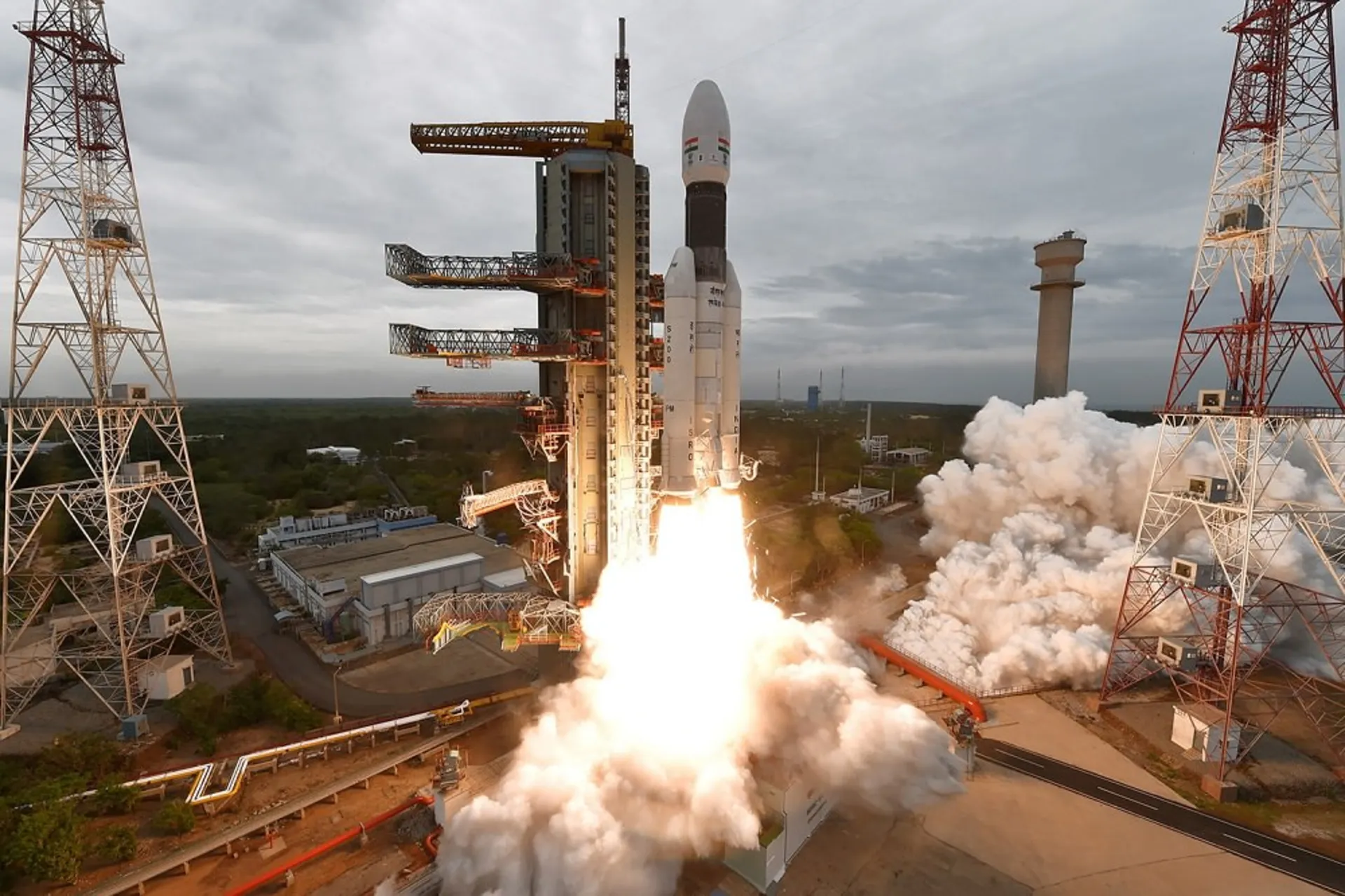
Chandrayaan 2 mission launch
However, the real challenge is getting the spacecraft out of orbit and landing it on the lunar surface; Because there is a delay in the communication between the Earth and the Moon, and the people in the control room who are present on the Earth cannot manually control the spacecraft in order to land it safely on the Moon. As a result, the spacecraft must descend automatically, and to do so, it will fire its descent engines to slow its speed from thousands of kilometers per hour to about one meter per second, in order to make a safe landing on the lunar surface.
For this reason, the director of the Indian Space Research Organization (ISRO), who was trying to land the Vikram lander last month, described the final descent of the spacecraft as “frightening 15 minutes”; Because as soon as the spacecraft enters the landing stage, the control of its status is out of the hands of the mission control members. They can only watch the spacecraft land and hope that everything goes according to plan, that hundreds of commands are executed correctly, and that the automatic landing systems gently bring the spacecraft closer to the surface of the moon.
The Great Unknown: The Landing Surface
One of the biggest challenges in the final descent phase is identifying the type of landing site. Despite the availability of instruments such as the Lunar Reconnaissance Orbiter (LRO) that can capture amazing views of the lunar surface, it is still difficult to know what kind of surface the spacecraft will encounter when it lands on the moon.
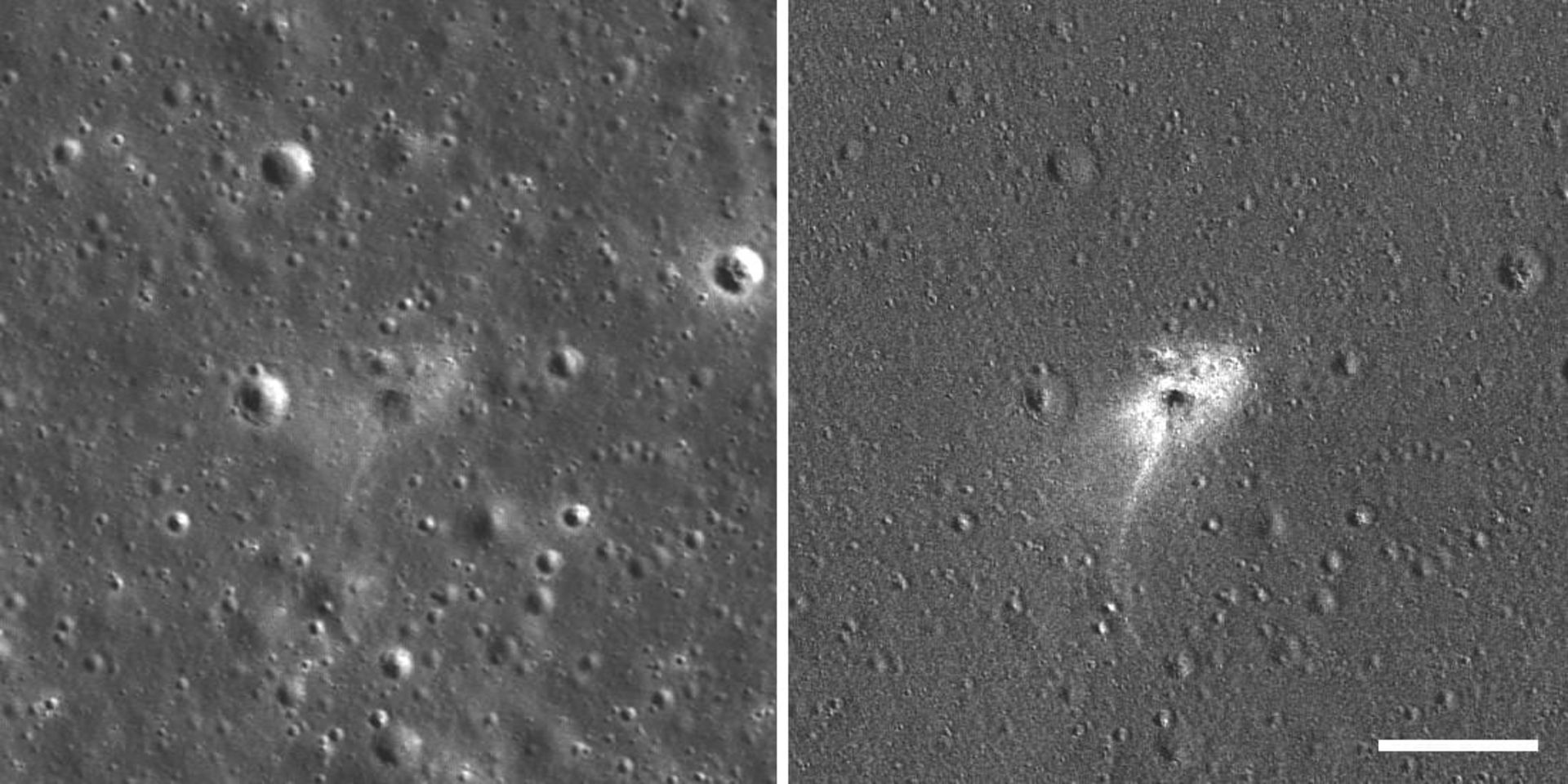
Left: Breshit crash site. Right: The ratio of the before and after images highlights the occurrence of minor changes in surface brightness.
Leonard David, author of Moon Fever: The New Space Race (2019) and veteran space reporter, says:
The Lunar Reconnaissance Orbiter is a very valuable asset that has performed really well over the years; But when you get a few meters above the surface of the moon, complications appear that cannot be seen even with the very powerful LRO camera.
Even today, despite the imaging data available, “some landing sites still have unknown remains,” Riley says. He notes that the Apollo 11 mission included an advantage that today’s unmanned landers lack, which is the presence of an astronaut’s observer’s eyes that can closely observe the surface of the spacecraft’s landing site. As you probably know, in the mission that led to the landing of the first man on the surface of the moon, the Eagle computer was guiding the spacecraft to a place full of boulders; But to avoid hitting the rocky surface of the moon, Armstrong took control of the spacecraft himself and landed it on a flat surface.
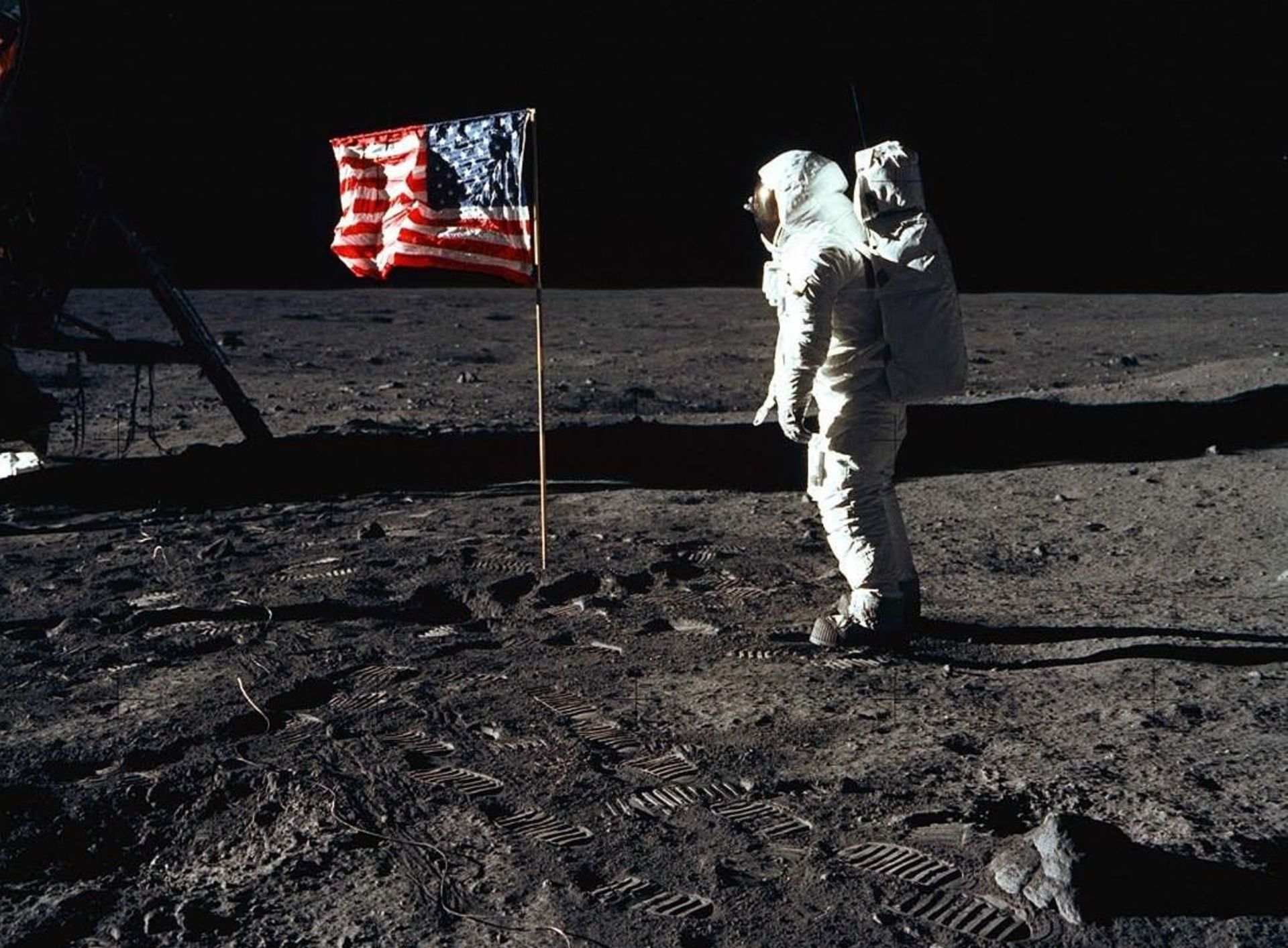
The uneven surface of the landing site had caused many problems in previous lunar missions such as Apollo 15. In this mission, the astronauts were told that as soon as the spacecraft touched the surface of the moon, they should turn off the engines to prevent dust from being sucked in and the risk of a return explosion. But the Apollo 15 spacecraft landed in a crater, and because of this, one of its legs came into contact with the surface earlier than the others. When the crew shut down the engines, the spacecraft, moving at a speed of 1.2 meters per second, experienced a hard landing. The lander landed at an oblique angle, and although it eventually landed safely, it nearly overturned, causing a fatal disaster.
- Half a century after Apollo 11; How did the great human leap happen?
- dust storms; The nightmare of space missions to the moon
The difficult landing of Apollo 15 introduced another complicating factor in lunar landings: lunar dust. The Earth’s moon is covered with dust that is thrown into the air by any movement and sticks to everything it comes in contact with. As the spacecraft approaches the surface of the moon, huge plumes of dust are kicked up that limit the field of view and endanger the spacecraft’s electronics and other systems. We still do not have a solution to deal with the dust problem.
An achievement that has been achieved before
Another reason why the moon landing remains a challenge is that gaining public support for lunar projects seems difficult. Referring to Neil Armstrong and Buzz Aldrin, the two astronauts who walked on the moon during the Apollo 11 mission, David says, “We convinced ourselves that we had sent Neil and Buzz [to the surface of the moon]; “As a result, when it comes to lunar missions, people may say we’ve been there before and we’ve had this success.”
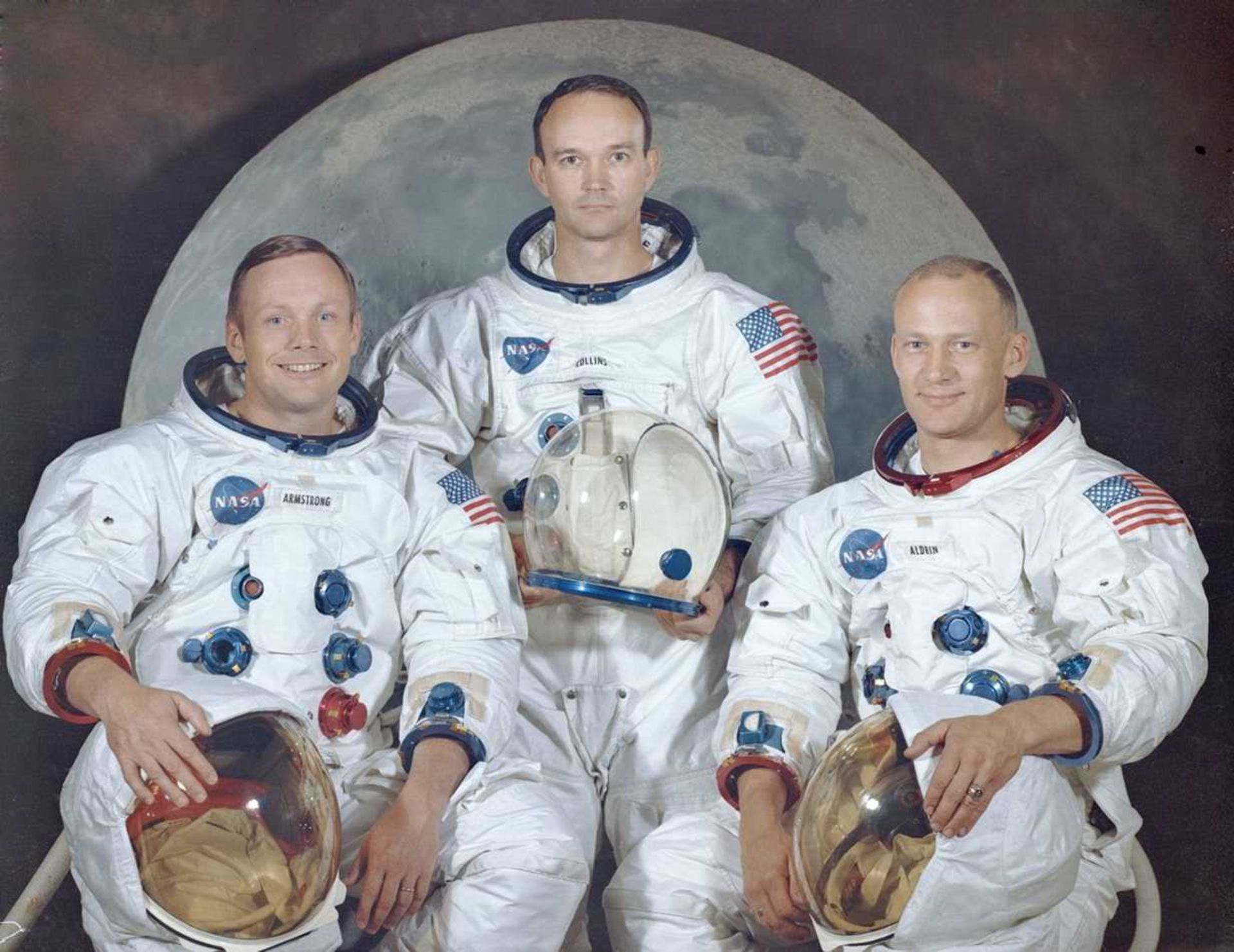
But in reality, our understanding of the moon is still very little, especially in relation to long-term missions. Now, with a 50-year gap between the Apollo missions and NASA’s upcoming Artemis project, the knowledge gained has been lost as engineers and specialists retire. David says:
We need to recover our ability to travel into deep space. We haven’t gone beyond near-Earth orbit since Apollo 17 and since 1972. NASA is no longer the same organization that put men on the moon, and there is a whole new generation of mission operators.
The importance of redundancy
As the first private spacecraft entered into orbit around the moon, the Space project was of considerable importance; But its failure to land smoothly on the surface of the moon made the achievement of landing on the surface of the moon still remain in the hands of governments. However, we can expect more private companies, such as Jeff Bezos ‘ Blue Origin, which is developing its lunar lander, to target the moon in the future. According to Elon Musk, even the giant SpaceX Starship spacecraft, which is being built with the ultimate goal of sending a human mission to Mars , can also land on the moon.
According to David, private companies’ participation in lunar landings has advantages such as increased innovation. However, companies are under pressure to save money, and this can lead to a lack of redundancy and support systems that are essential in the event of errors and malfunctions. Lunar rovers typically include two or even three layers of support systems. David is concerned that private companies will be encouraged to eliminate these redundancies in order to cut costs and save money.

Crew Dragon SpaceX passenger capsule
“We saw Elon Musk’s Dragon capsule catch fire after a failed test on the stand,” says David, referring to the explosion of the SpaceX spacecraft in April, which had no crew on board. “This accident was kind of a wake-up call about how unpredictable the performance of spacecraft can be.” David compared the Crew Dragon incident to the Apollo 1 disaster, which killed three NASA astronauts during a test launch in 1967.
Another problem related to the lack of redundancy systems is the lack of information needed when an error occurs. As for the recent landings, it seems that the SpaceX crash was caused by human error; however, it is not clear what caused the failure of Chandrayaan 2 in the calm landing, and it is possible that without the necessary systems to record and send information to the lander, we will never find out the main reason for the failure of this mission. Without the required data, it becomes much more difficult to prevent problems from reoccurring in the future.
The future of lunar landings
Currently, many projects are underway to facilitate future moon landings. Ultimately, we need to be able to build the necessary infrastructure for a long-term stay on the moon.
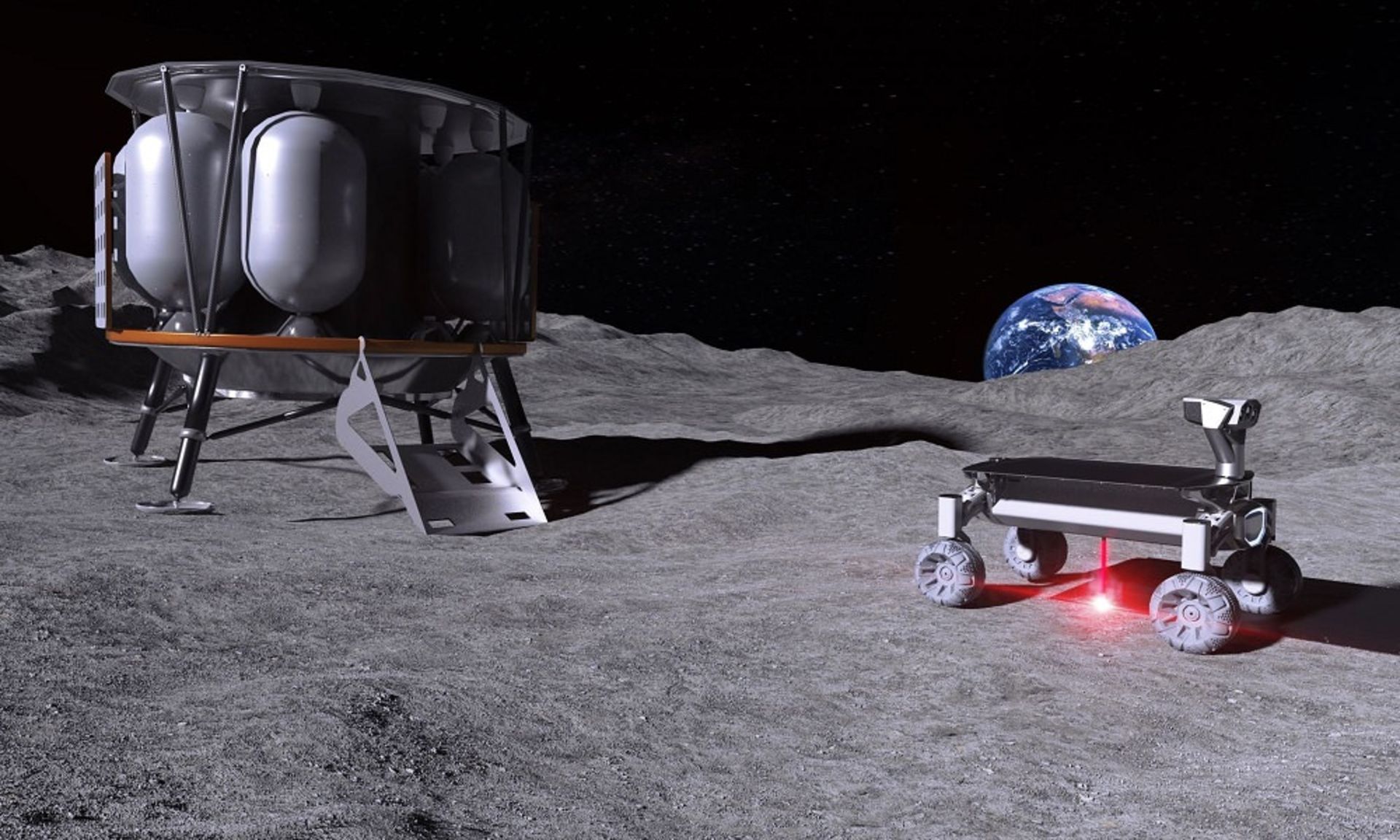
Conceptual design of Moonrise technology on the moon. On the left side is the Alina lunar module, and on the right side, the lunar rover equipped with Moonrise technology melts the lunar soil with the help of a laser.
If we can make long-term stays on the moon possible, or even build a permanent base there, landing spacecraft on the lunar surface will be much easier. By constructing the landing sites, a flat, safe, and free surface of unknown debris can be created for the landing of surface occupants. For example, researchers are currently conducting research at NASA’s Kennedy Space Center to investigate the feasibility of using microwaves to melt the lunar soil (regolith) and turn it into a hard foundation so that it can be used as a landing and launch site. The European Space Agency is also investigating how to use 3D printing to create landing sites and other infrastructure on the moon.
Read more: Europa Clipper, NASA’s flagship probe was launched
Other ideas include the use of lidar remote sensing systems, which are similar to radar systems; But instead of radio waves, it uses lasers to land the spacecraft. Lidar technology provides more accurate readings and uses a network of GPS satellites to help guide the spacecraft during landing.
The problem of public support
As important as technology is, public interest and support are essential to the success of the lunar landing program. “Apollo had enormous resources that are perhaps only comparable today to China’s space program,” says Riley. “Remember that Apollo carried the best computer imaginable, the human brain.” It goes without saying that there is an element of luck involved in every landing.
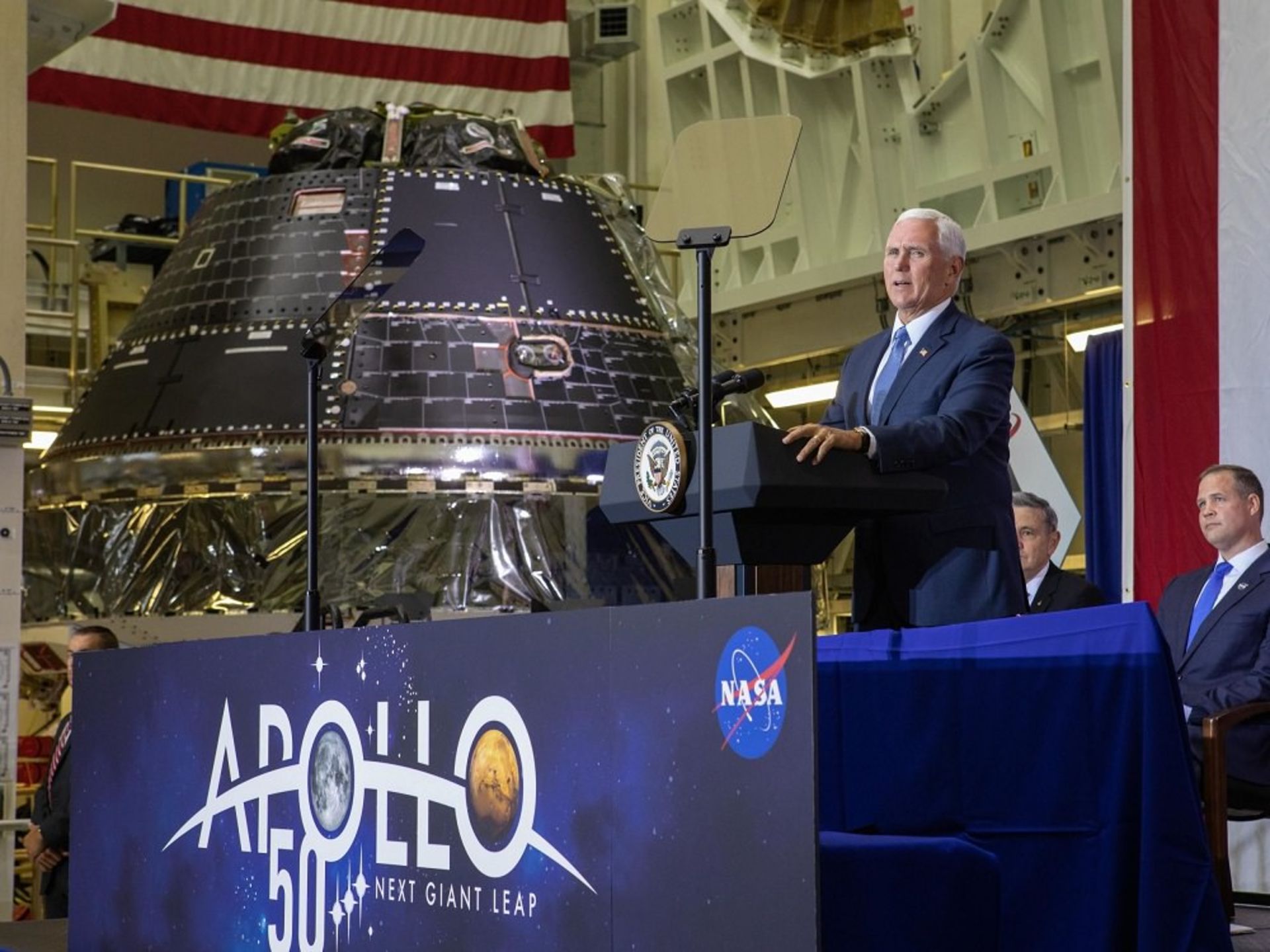
US Vice President Mike Pence speaking at the 50th anniversary of the Apollo 11 mission
Finally, there is the question of what kind of failure is acceptable for people. David says:
I think we have to be serious about the fact that we’re probably going to lose people. There is a serious possibility that the manned lunar lander will crash and kill the astronauts inside. The American people continued to support NASA despite the failures and bad luck of the Apollo program, But at that time there was a lot of pressure to compete with the Soviet Union. Without the bipolar atmosphere of the Cold War and the space race, would people still support missions with human lives in between?


Europa Clipper, NASA’s flagship probe was launched
After years of waiting, NASA’s Europa Clipper probe was finally launched on Monday at 7:36 p.m. Iran time from the Kennedy Space Center on top of SpaceX’s Falcon Heavy rocket and began a major astrobiology mission to Europa, the potentially habitable moon of Jupiter.
As SpaceX’s massive rocket powered by 27 powerful Merlin engines lifted off from pad 39A, NASA live broadcast reporter Dron Neal said, “The launch of Falcon Heavy with Europa Clipper will reveal the secrets of the vast ocean beneath the icy crust of Europa, Jupiter’s moon. It has been hidden, it will reveal.”
The engines of the two side boosters of the Falcon Heavy were shut down and separated from the central booster approximately three minutes after the flight. The central booster continued to fly for another minute, and then in the fourth minute of the launch, the separation of the upper stage from the first stage was confirmed. Finally, 58 minutes later, Europa Clipper was injected into interplanetary orbit as scheduled. A few minutes later, the mission team made contact with the probe, and people in the control room cheered and applauded.
Falcon Heavy’s unique launch
The launch of NASA’s new probe was delayed due to some mishaps. NASA and SpaceX initially planned to launch the Europa Clipper mission on Thursday, October 10; But with powerful Hurricane Milton hitting Florida’s Gulf Coast on Wednesday evening, a delay in the launch became inevitable. NASA shut down Kennedy Space Center to deal with the storm, and Europa Clipper was placed inside SpaceX’s hangar near Launch Pad 39A.
The recent launch was Falcon Heavy’s 11th flight overall and its second interplanetary mission. Also, this was the first flight of the Falcon Heavy, when all three boosters of the first stage of the rocket were deployed.
Typically, the Falcon Heavy and Falcon 9 first-stage boosters store enough fuel to perform landing maneuvers for recovery and reuse in the future; But Europa Clipper needed all the power that Falcon Heavy could provide in order to make it on its way to the Jupiter system.
A long way to the launch pad
In late 2015, the US Congress directed NASA to launch Europa Clipper using the Space Launch System (SLS), NASA’s massive rocket. SLS was still under construction at the time and was several years away from reaching the launch pad. The delay in completing the construction of this powerful rocket and NASA’s need to assign at least the first three versions of SLS to the Artemis lunar mission caused the Europa Clipper launch date to be in an aura of uncertainty.
In the 2021 House budget draft for NASA, the agency was directed to launch Europa Clipper by 2025 and, if possible, with SLS. However, due to the unavailability of the Space Launch System, NASA had to go to SpaceX’s Falcon Heavy. This decision was not without cost. As the most powerful rocket ever used in an operational mission, SLS can send Europa Clipper directly to the Jupiter system in less than three years.
Europa Clipper will use the gravitational assistance of Mars and Earth on its way to the Jupiter system
Now, even in Falcon Heavy’s fully disposable mode, the Clipper’s trip to Europe takes almost twice as long. The probe should make a flyby of Mars in February 2025 and a flyby of Earth in December 2026 to gain enough speed to reach its destination in April 2030.
Missile problems were not the only obstacles facing Europa Clipper on its way to the launch pad. For example, the rising costs of this five billion dollar probe forced NASA to cancel the construction of one of the probe’s science instruments. This instrument, named “Identification of Europa’s internal features using a magnetometer” (ICEMAG), was designed to measure Europa’s magnetic field.
Then in May 2024, NASA found that transistors similar to those used in Europa Clipper, which are responsible for regulating the probe’s electricity, were “failing at lower-than-expected radiation doses.” Following this discovery, NASA conducted more tests on the transistors and finally concluded in late August that these components could support the initial mission in the radiation-rich environment around Jupiter.
Ambitious mission to a fascinating moon

NASA/Jet Propulsion Laboratory-Caltech
Europa Clipper is one of NASA’s most exciting and ambitious flagship missions, and it has impressive features. For example, the mission probe is the largest spacecraft NASA has ever built for a planetary mission. Europa Clipper weighed almost 6,000 kg at the time of launch and will be more than 30 meters long (bigger than a basketball court) by opening its huge solar panels in space.
Clipper’s Europa destination is also a prominent location: Europa, one of Jupiter’s four Galilean moons. The moon is covered with an icy outer shell, which scientists believe hides a vast ocean of salty liquid water. For this reason, Europa is considered one of the best places in the solar system to support alien life.
In early 2012, studies began to look for potential plumes of water rising from Europa’s surface. Some researchers theorize that those water columns and vents from which the columns protrude may contain evidence of life living beneath the moon’s icy crust. However, NASA scientists have made it clear that Europa Clipper is not looking for extraterrestrial life in Europa; Rather, this probe will only investigate the potential of the submoon water environment to support life.
“If there’s life on Europa, it’s going to be under the ocean,” Bonnie Buratti, senior Europa Clipper scientist at NASA’s Jet Propulsion Laboratory, said in September. As a result, we cannot see it.” “We will be looking for organic chemicals that are prerequisites for life on the surface of the moon,” Borrati added. There are things we can observe; such as DNA or RNA; But we don’t expect to see them. As a result, [the probe] is only looking for habitable environments and evidence for the ingredients of life, rather than life itself.”
NASA scientists have made it clear that Europa Clipper is not looking for extraterrestrial life in Europa
Europa Clipper will collect data using a suite of nine scientific instruments, including visible and thermal cameras, several spectrometers, and special equipment to identify Europa’s magnetic environment. As stated on NASA’s Europa Clipper page, the probe will help scientists achieve three main goals:
- Determining the thickness of Europa’s ice sheet and understanding how Europa’s ocean interacts with the lunar surface.
- Investigating the composition of Europa’s ocean to determine whether it has the materials necessary to form and sustain life.
- Studying the formation of Europe’s surface features and discovering signs of recent geological activities; such as the sliding of crustal plates or the discharge of water columns in space.
Europa Clipper also transports Earth’s culture to the Solar System. A piece called “In Praise of Mystery: A Poem for Europe” by Edda Lemon, a famous American poet, is engraved in the artist’s own handwriting on a metal plate. In addition, the probe carries a coin-sized chip that contains the names of 2.6 million inhabitants of planet Earth.
6-year journey

Johns Hopkins University Applied Physics
If all goes according to plan, Europa Clipper will enter Jupiter’s orbit in April 2030. When the probe gets there, it will use up 50-60% of its 2,722 kg of fuel by performing an injection maneuver for 6-8 hours.
The injection maneuver puts Europa Clipper in an elliptical orbit around the gas giant. A series of long maneuvers will then be performed to align the trajectory so that the probe can fly by Europa more than 45 times and study it closely. In fact, Europa Clipper will remain around Jupiter throughout its mission; Because according to the launch environment of Europa, it will be very dangerous for the spacecraft to go around the moon.
If all goes according to plan, Europa Clipper will enter Jupiter’s orbit in April 2030
The first flight over Europe will not take place before the spring of 2031. NASA will use the first pass to make further corrections to Europa Clipper’s trajectory in preparation for the probe’s first science mission. With the start of scientific flybys in May 2031, Europa Clipper will aim its array of sensors towards the far hemisphere from Jupiter and will approach the surface of the moon up to 25 km. The second science campaign will begin two years later, in May 2033, in the Jupiter-facing hemisphere of Europa.
The end of the Europa Clipper mission is set for September 2034. At that time, NASA will crash the spacecraft into Ganymede, another Galilean moon of Jupiter. This disposal strategy was chosen because Ganymede is considered a relatively poor candidate to host life, and the mission team wanted to make sure they did not contaminate potentially life-hosting Europa with terrestrial microbes.
Space
Dark matter and ordinary matter can interact without gravity!
Published
3 weeks agoon
01/10/2024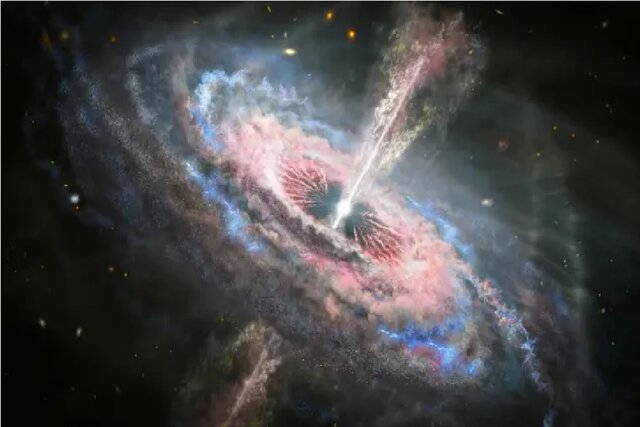

Preposition: For each; per.
Noun: A topology name.
Noun: which has mass but which does not readily interact with normal matter except through gravitational effects.
Adverb: Beyond all others.
Preposition: For each; per.
Noun: A topology name.
Dark matter and ordinary matter can interact without gravity!
Why is dark matter associated with the adjective “dark”? Is it because it harbors some evil forces of the universe or hidden secrets that scientists don’t want us to know? No, it is not. Such fanciful assumptions may sound appealing to a conspiracy theorist, but they are far from the truth.
Dark matter is called dark because it does not interact with light. So when dark matter and light collide, they pass each other. This is also why scientists have not been able to detect dark matter until now; it does not react to light.
Although it has mass and mass creates gravity, this means that dark matter can interact with normal matter and vice versa. Such interactions are rare, and gravity is the only known force that causes these two forms of matter to interact.
However, a new study suggests that dark matter and ordinary matter interact in ways other than gravity.
If this theory is correct, it shows that our existing models of dark matter are somewhat wrong. In addition, it can lead to the development of new and better tools for the detection of dark matter.
Read more: There is more than one way for planets to be born
A new missing link between dark and ordinary matter
Dark matter is believed to have about five times the mass of normal matter in our universe, which helps hold galaxies together and explains some of the motions of stars that don’t make sense based on the presence of visible matter alone.
For example, one of the strongest lines of evidence for the existence of dark matter is the observation of rotation curves in galaxies, which show that stars at the outer edges of spiral galaxies rotate at rates similar to those near the center. These observations indicate the presence of an invisible mass.
Also, for their study, the researchers studied six ultra-dim dwarf (UFD) galaxies located near the Milky Way. However, in terms of their mass, these galaxies have fewer stars than they should. This means they are mostly made up of dark matter.
According to the researchers, if dark matter and normal matter interact only through gravity, the stars in these UFDs should be denser in the centers and more spread out toward the edges of the galaxies. However, if they interact in other ways, the star distribution looks different.
The authors of the study ran computer simulations to investigate both possibilities. When they tested this for all six ultra-dim dwarf (UFD) galaxies, they found that the distribution of stars was uniform, meaning that the stars were spread evenly across the galaxies.
This was in contrast to what is generally observed for gravitational interactions between dark matter and normal matter.
What causes this interaction?
The results of the simulations showed that gravity is not the only force that can make dark matter and normal matter interact. Such an interaction has never been observed before, and it could change our understanding of dark matter and dark energy.
However, this study has a major limitation. What caused the interaction between the two forms of matter is still a mystery. While the current study provides tantalizing hints of a novel interaction, its exact nature and underlying causes remain unknown. Hopefully, further research will clarify the details of such interactions.
This study was published in The Astrophysical Journal Letters.


Ancient humans survived the last ice age just fine


iPhone 16 Pro Review


Why is the colon cancer increasing in people younger than 50?


Why is it still difficult to land on the moon?


Biography of Geoffrey Hinton; The godfather of artificial intelligence


The Strawberry Project; The OpenAI artificial intelligence model


Everything you need to know about the Windows Blue Screen of Death


Starlink; Everything you need to know about SpaceX Satellite Internet


iOS 18 review: A smart update even without Apple’s intelligence


There is more than one way for planets to be born
Popular
-



 Technology1 year ago
Technology1 year agoWho has checked our Whatsapp profile viewed my Whatsapp August 2023
-



 Technology1 year ago
Technology1 year agoSecond WhatsApp , how to install and download dual WhatsApp August 2023
-



 Technology1 year ago
Technology1 year agoHow to use ChatGPT on Android and iOS
-



 AI2 years ago
AI2 years agoUber replaces human drivers with robots
-



 Technology1 year ago
Technology1 year agoThe best Android tablets 2023, buying guide
-



 Technology1 year ago
Technology1 year agoThe best photography cameras 2023, buying guide and price
-



 Humans2 years ago
Humans2 years agoCell Rover analyzes the inside of cells without destroying them
-



 Technology1 year ago
Technology1 year agoHow to prevent automatic download of applications on Samsung phones

